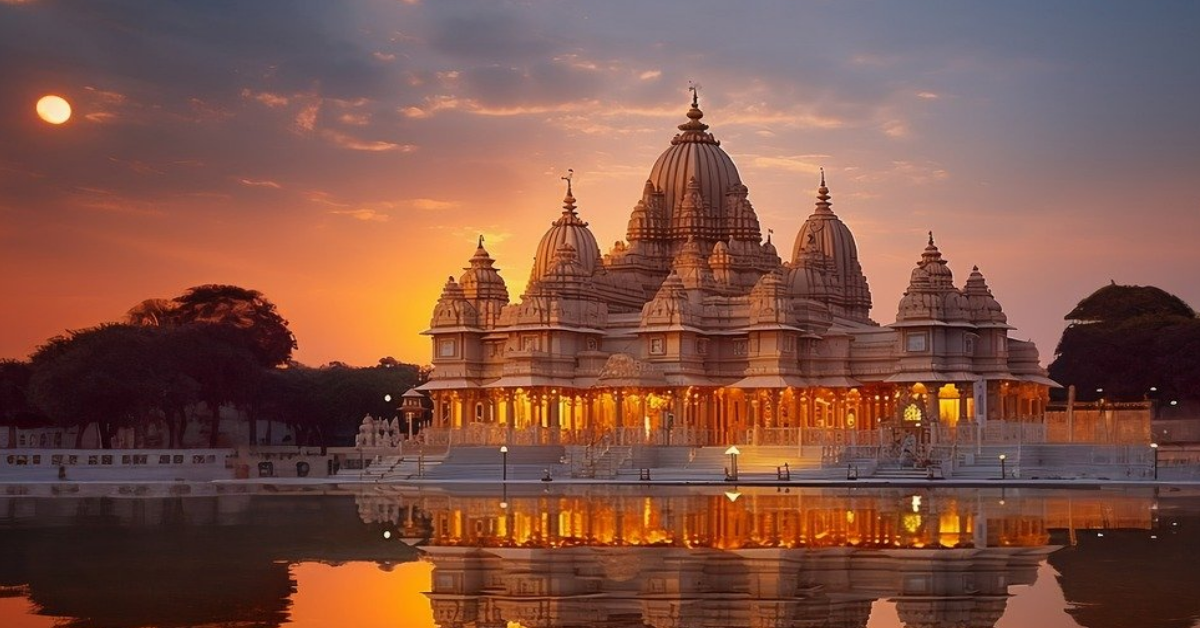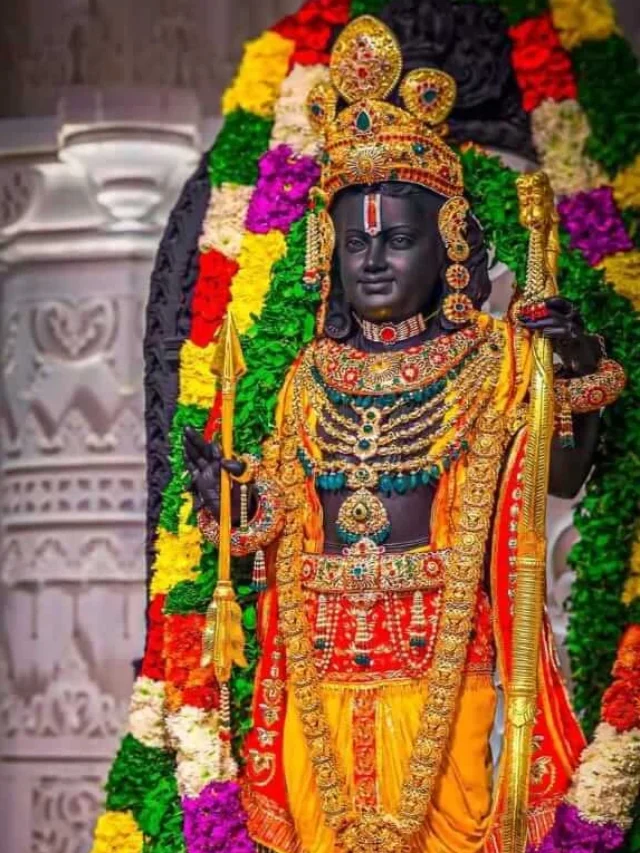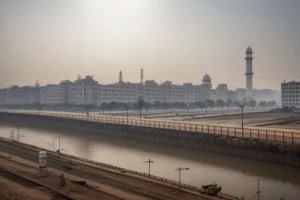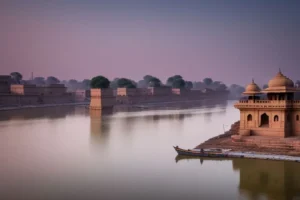Rising majestically in the city of Ayodhya, Uttar Pradesh, the Ram Mandir Ayodhya is not just a temple, but a symbol of faith and cultural significance for millions of Hindus worldwide. Dedicated to Lord Rama, a revered deity in Hinduism, the temple is nearing completion after a long and complex history. Let’s delve into the details of this magnificent temple.
Table of Contents of Ram Mandir Ayodhya
Location Ram Mandir Ayodhya:
Ayodhya, Uttar Pradesh, India.
Distance from Key Transportation Hubs to Ram Mandir Ayodhya:
- Ayodhya Railway Station: 6 km (approximate)
- Faizabad Bus Stand: 5 km (approximate)
- Lucknow International Airport: 160 km (approximate)
Area of Ram Mandir Ayodhya:
Sprawling over a vast 2.7 acres, the temple complex includes the main shrine, six additional temples, and landscaped gardens.
Shri Ram Janmabhoomi Teerth Kshetra: The Guiding Force
Established in February 2020, this trust holds the responsibility of managing the Ram temple construction and surrounding 70 acres of land. It was formed following the Supreme Court’s historic 2019 verdict granting the disputed site to Ram Lalla, the deity representing Lord Rama.
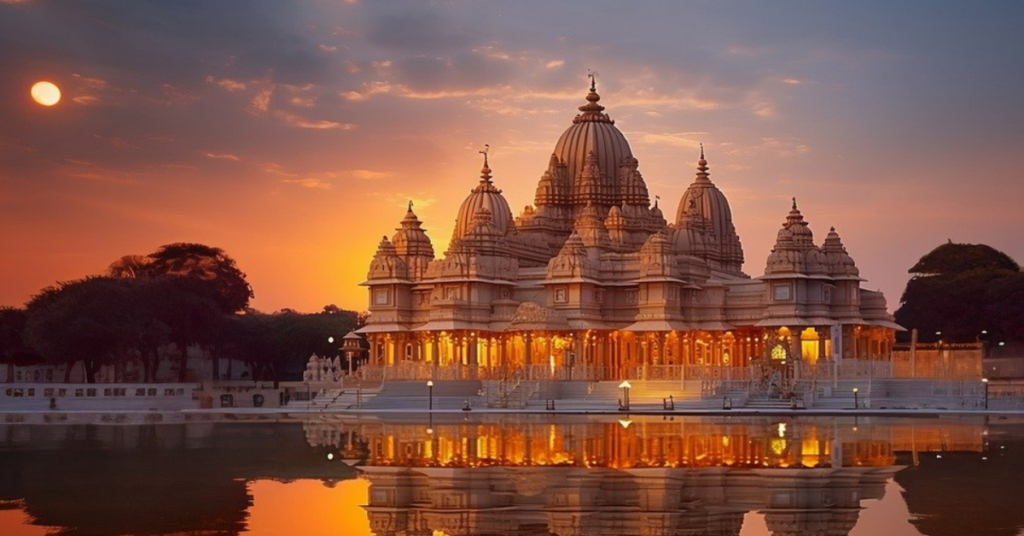
Bhoomi Pujan: A Momentous Occasion
On August 5th, 2020, amidst much fanfare and spiritual presence, Prime Minister Narendra Modi performed the Bhoomi Pujan ceremony, marking the official commencement of the temple’s construction. This event signified the culmination of decades of struggle and the realization of a cherished dream.
Architecture:
Inspired by traditional Nagara style, the Ram Mandir boasts intricate carvings, towering shikharas, and ornate mandapas. The temple will stand 161 feet tall, showcasing 12 grand gates and five porches.
The grand Ram Mandir in Ayodhya, Uttar Pradesh, is nearing completion, poised to become a landmark pilgrimage site for millions of Hindus worldwide.
A Sprawling Complex:
The temple complex encompasses a vast 2.7 acres, with the main shrine itself boasting a built-up area of 57,400 square feet. Its imposing stature is evident in its dimensions:
- Length: 360 feet
- Width: 235 feet
- Height (including peak): 161 feet
Rising in Three Tiers:
The temple proudly stands on three floors, each measuring 20 feet in height. The ground floor features a staggering 160 columns, supporting the structure with grace and strength. As you ascend to the first and second floors, the number of columns reduces to 132 and 74, respectively, creating a harmonious visual flow.
Five Majestic Mandapas and Twelve Grand Gates:
Adding to the temple’s grandeur are five exquisite pediments and pavilions, known as mandapas. These ornate structures provide spaces for congregational prayers, gatherings, and other religious ceremonies. Twelve grand gates welcome devotees and pilgrims, each intricately carved to signify auspiciousness and devotion.
Materials:
Rajasthani pink sandstone forms the primary building material, chosen for its strength and aesthetic appeal. Other elements include marble, gold, and precious stones.
History of Ayodhya Ram Mandir:
The Ram Mandir has a long and intricate history, marked by religious disputes and legal battles. The site is believed to be the birthplace of Lord Rama, making it a deeply revered location for Hindus. The Babri Masjid, built in the 16th century, stood on the site until its demolition in 1992, sparking religious tensions. After decades of legal proceedings, the Supreme Court of India in 2019 awarded the disputed land to a trust for the construction of the Ram Mandir.
Special Gifts for Pran Pratishtha:
The upcoming inaugural ceremony, known as Pran Pratishtha, is expected to witness a grand celebration. Out of tremendous love and affection several devotees offered gifts for this historical event for Shri Ram Mandir, these offerings, imbued with deep faith and artistic brilliance, reflect the immense significance surrounding this historic event.
A 108-Foot-Long Incense Stick for a Fragrant Welcome:
Imagine a colossal incense stick, measuring 108 feet in length and weighing a staggering 3,610 kg! This magnificent creation, hailing from Vadodara, Gujarat, will soon grace the Ram Mandir. Crafted with environmentally friendly materials including guggul, coconut shells, ghee, cow dung, and herbs, it’s set to burn for a month and a half, filling the air with its divine fragrance for miles around.
A Towering Bell and a Symbolic Lock:
A grand 2,100 kg bell, meticulously crafted from ‘ashtadhatu’ (an eight-metal alloy), has arrived from Jalesar in Uttar Pradesh. This resonant marvel, a testament to the artisans’ skill, will soon toll its auspicious notes within the temple complex. Additionally, a 400 kg lock and key, measuring a staggering 10 feet in height, has been presented by a locksmith from Aligarh. This symbolic offering signifies the temple’s sanctity and security.
Timeless Devotion in a Multi-Country Clock:
A Lucknow-based vegetable vendor has presented a unique clock to the Ram Mandir trust. This ingenious creation displays the time in eight different countries simultaneously, including India, Japan, Russia, UAE, China, Singapore, Mexico, and the United States. This innovative gift embodies the temple’s universal significance and its potential to unite devotees across the globe.
Sweet Offerings and Exquisite Adornments:
Chef Vishnu Manohar from Nagpur has pledged to prepare a whopping 7,000 kg of “Ram Halwa,” a traditional sweet dish, to be distributed to devotees during the consecration ceremony. The Shri Krishna Janmasthan Seva Sansthan in Mathura is preparing 200 kg of laddu as an offering for a ‘yagya,’ while the Tirumala Tirupati Devasthanams (TTD) will be sending a staggering one lakh laddu for distribution.
A special saree adorned with intricate images of Lord Ram and the Ayodhya temple, woven in Surat, will be offered to Ma Janaki, the revered consort of Lord Ram. Additionally, a diamond merchant from Surat has crafted a stunning necklace using 5,000 American diamonds and 2 kg of silver, inspired by the Ram temple architecture. This magnificent piece will be a cherished possession of the temple.
A Walk of Devotion and a Glowing Beacon:
Challa Srinivas Sastry, a 64-year-old devotee from Hyderabad, has undertaken an incredible feat of walking nearly 8,000 km on foot to present gold-plated footwear for Lord Ram. His unwavering dedication and desire to fulfill his late father’s dream embody the spirit of countless devotees who have contributed to the Ram Mandir’s construction.
Finally, a giant lamp weighing 1,100 kg, crafted from ‘panchadhatu’ by a farmer from Vadodara, will illuminate the temple with its radiant glow. This magnificent creation, measuring 9.25 feet in height and 8 feet in width, can hold a staggering 851 kg of ghee, symbolizing the abundance of blessings bestowed upon the temple.
These are just a few examples of the many extraordinary gifts that are pouring into the Ram Mandir. Each offering, imbued with love, faith, and artistic excellence, adds to the grandeur and significance of this historic temple. As the consecration ceremony approaches, the world eagerly awaits to witness the culmination of this decades-long dream, and the Ram Mandir stands poised to become a beacon of spiritual enlightenment for generations to come.
Important Parts of the Ram Mandir Ayodhya:
- Garbhagriha: The innermost sanctum sanctorum where the idols of Lord Rama, Sita, Lakshmana, and Hanuman will be enshrined.
- Mandapas: Large, pillared halls for congregational prayers and gatherings.
- Shikharas: The towering spires atop the temple, symbolizing its upward ascent towards the heavens.
- Param Shikhar: The central and tallest spire, reaching 161 feet and adorned with intricate carvings.
Ram Mandir Ayodhya Court Case Details:
The Ram Janmabhoomi land dispute was one of the longest-running legal battles in India. The case lasted for decades, involving multiple petitions and hearings. Finally, in 2019, the Supreme Court delivered a landmark verdict, paving the way for the construction of the Ram Mandir. It’s a complex narrative marked by historical claims, contested ownership, and societal tensions. Let’s delve into the journey of this case:
The Site of Ram Mandir Ayodhya:
At the heart of the case lies a 2.77-acre plot in Ayodhya, Uttar Pradesh. Hindus from centuries worshipped the place as the birthplace of Lord Shri Rama, a revered deity, and claim a temple dedicated to him stood there before being demolished by Mughal emperor Babur in the 16th century, leading to the construction of the Babri Masjid. Muslims, on the other hand, assert their right to the site based on the mosque’s presence.
A Chronology of Legal Battles:
- 1885: The first lawsuit regarding the site is filed by Mahant Raghubar Das, seeking permission to build a platform for worship.
- 1949: Idols of Lord Rama appear within the Babri Masjid, triggering communal clashes. The site is locked and placed under government control.
- 1950: Sunni Waqf Board files a suit claiming ownership of the mosque.
- 1986: The Faizabad district court allows Hindus to perform daily worship at the site.
- 1992: The Babri Masjid is demolished by Hindu kar sevaks, sparking nationwide riots.
- 1994: Liberhan Commission is formed to investigate the demolition.
- 2002: Allahabad High Court orders archaeological excavations at the site.
- 2010: High Court delivers a divided verdict, splitting the land into three parts for Hindus, Muslims, and the Nirmohi Akhara, a Hindu monastic order.
- 2019: Supreme Court begins daily hearings on the case.
- 2019: In a landmark verdict, the Supreme Court grants the entire disputed land to a trust for the construction of the Ram Mandir. Muslims are to be allotted an alternate 5-acre plot for a mosque.
Key Arguments and Judgments:
- Hindus: Presented historical and archaeological evidence proved the existence of an ancient Ram temple at the site. The court acknowledged the presence of a temple structure beneath the mosque.
- Muslims: Claimed ownership based on the Babri Masjid’s presence and argued that demolishing it violated their right to worship. The court upheld their right to a mosque but ruled that it could not be built at the temple site.
- Nirmohi Akhara: Claimed shebait (caretaker) rights to the site and argued for exclusive possession. The court rejected their claim, finding insufficient evidence to establish their shebait status.
The Verdict’s Impact:
The Supreme Court’s verdict brought a long-awaited closure to the legal battle, paving the way for the construction of the Ram Mandir.
Disclaimer: While precautions have been taken during the writing of this article, there is a possibility that some information may have been overlooked or could benefit from additional review. If you identify any such instances, please do not hesitate to leave a comment for the author, providing any relevant evidence or documentation to support your suggestions for correction.
Frequently Asked Questions (FAQs)
Unveiling the Grand Ayodhya Ram Mandir: Significance of the Ram Mandir Ayodhya:
A deeply holy site for Hindus, believed to be the birthplace of Lord Rama, a central figure in the Ramayana.
A pilgrimage destination for millions, attracting devotees worldwide.
History of the Ram Mandir Ayodhya:
The site has a long and complex history, with disputes surrounding its ownership.
A historic judgement in 2019 paved the way for the construction of the Ram Mandir.
Visiting the Ram Mandir Ayodhya:
Reaching the Temple: By train: Ayodhya Junction Railway Station.
By road: Well-connected by buses and taxis from major cities.
By air: Limited air connectivity to Ayodhya Airport (AYD). Many fly into Lucknow International Airport (LKO) and then travel by road.
Location: Ayodhya, Uttar Pradesh, India. You can find it on Google Maps.
Timings and Entry: Check for current darshan timings as they may vary. Entry is free.
Accommodation: Hotels are available near the temple.
By train: Ayodhya Junction Railway Station.
By road: Well-connected by buses and taxis from major cities.
By air: Limited air connectivity to Ayodhya Airport (AYD). Many fly into Lucknow International Airport (LKO) and then travel by road.
Planning Your Visit:
Budget moderately for your visit.
It’s wise to plan in advance, especially during peak seasons.
Light offerings (dhoop & agarbatti) are permitted, but check for size restrictions.
Prasad (blessed food) is often distributed free of charge.
Additional Information:
The architecture is designed in the North Indian Temple style.
For the latest news and information, reputable news sources or the official website (if available) are recommended.
Photography is generally allowed within the temple complex.


